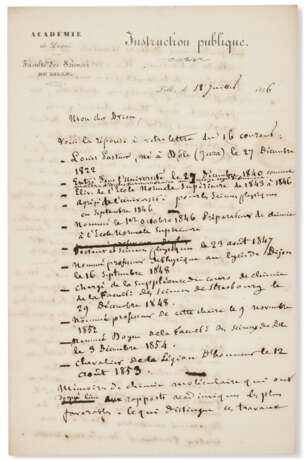ID 1032755
Lot 103 | On his most important scientific discoveries
Estimate value
$ 5 000 – 7 000
In French. Three pages, bifolium, 209 x 134mm, on Académie de Douai, Faculté des Sciences letterhead.
Pasteur recounts his academic career highlighting what he regarded as his most significant discoveries in molecular chemistry, the identification of molecular chirality, and of isometric properties and their relation to biochemical activity or neutrality, "his first and in some ways his greatest scientific discovery." (Bernal) A fascinating letter with significant scientific content, which Pasteur wrote to provide material for an article in the French newspaper La Revue. Pasteur opens providing his correspondent with a curriculum vitae up to the end of 1854, outlining his academic career, posts held, and appointments and honors. He then summarizes his experimental program in molecular chemistry and highlights what he considers his most significant work: "Discoveries in molecular chemistry led to the most favorable academic reports. What distinguishes the work from the results is the scientist’s method. [I] debated the difficult problems of the molecular constitution of natural organic products by taking the chemical studies of the resources of physics and crystallography into consideration." Pasteur then discusses in detail his work on asymmetry and optical activity, which was his principal area of research in the period 1847-57: "All objects are grouped into two large categories depending on their shape. The objects in the first category have a shape that is stackable. The objects in the second category are not stackable. They do not fit each other, just like a glove for the right hand is not suitable for the left hand. However, [I] recognized that the shape of all the natural substances, meaning those which have been developed under the influence of plant life, are asymmetrical like a hand or a spiral staircase. According to scientific research, asymmetry certainly occurs. The elementary atoms form groups within the individual molecule, but this asymmetry of organic individuals is not a necessary condition of the existence of the molecule. You can make it disappear or turn it into the opposite of what it is, almost as if the steps of a spiral staircase were replaced by a straight staircase or one in the opposite direction. One of the most important discoveries in my research is the discovery of the remarkable relations that exist between the phenomenon of the rotatory polarization and the asymmetric constitution of the organic molecules."
Pasteur rose to the status of a national hero during his lifetime. However, perhaps surprisingly, Gerald Geison, a historian who has made a detailed study of Pasteur’s life and work observes: “His contributions to basic science were extensive and very significant, but less revolutionary than his reputation suggests. Pasteur’s most profound and most original contributions to science [i.e. these are the ones in the field of molecular chirality and crystallography] are also the least famous, and they came at the very outset of his career.” (p. 35) Bernal, a crystallographer, concurs "'…his first and in some ways his greatest scientific discovery'" (p. v).
Charles Alexandre Drion (1827-63) was educated at the Ecole Normale Supérieure, graduating in 1847. From 1854 to 1859 he was Professeur de Physique at the Lycée de Versailles. He earned his doctorate in 1859 with a thesis entitled "Recherches sur la dilatabilité des liquides volatils." The following year he was appointed Chargé de Cours at the University of Besançon, rising to professor in 1862.
See Gerald L. Geison, The Private Science of Louis Pasteur (1995) J.D. Bernal, Science and Industry in the Nineteenth Century (2102); H.D. Flack, "Louis Pasteur’s discovery of molecular chirality and spontaneous resolution in 1848, together with a complete review of his crystallographic and chemical work," Acta Crystallographica A65 (2009), 371-89.
| Artist: | Louis Pasteur (1822 - 1895) |
|---|---|
| Place of origin: | France |
| Auction house category: | Letters, documents and manuscripts, Medicine & science |
| Artist: | Louis Pasteur (1822 - 1895) |
|---|---|
| Place of origin: | France |
| Auction house category: | Letters, documents and manuscripts, Medicine & science |
| Address of auction |
CHRISTIE'S 20 Rockefeller Plaza 10020 New York USA | ||||||||||||||
|---|---|---|---|---|---|---|---|---|---|---|---|---|---|---|---|
| Preview |
| ||||||||||||||
| Phone | +1 212 636 2000 | ||||||||||||||
| Fax | +1 212 636 4930 | ||||||||||||||
| Conditions of purchase | Conditions of purchase | ||||||||||||||
| Shipping |
Postal service Courier service pickup by yourself | ||||||||||||||
| Payment methods |
Wire Transfer | ||||||||||||||
| Business hours | Business hours
|












